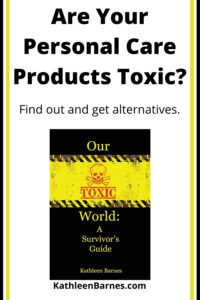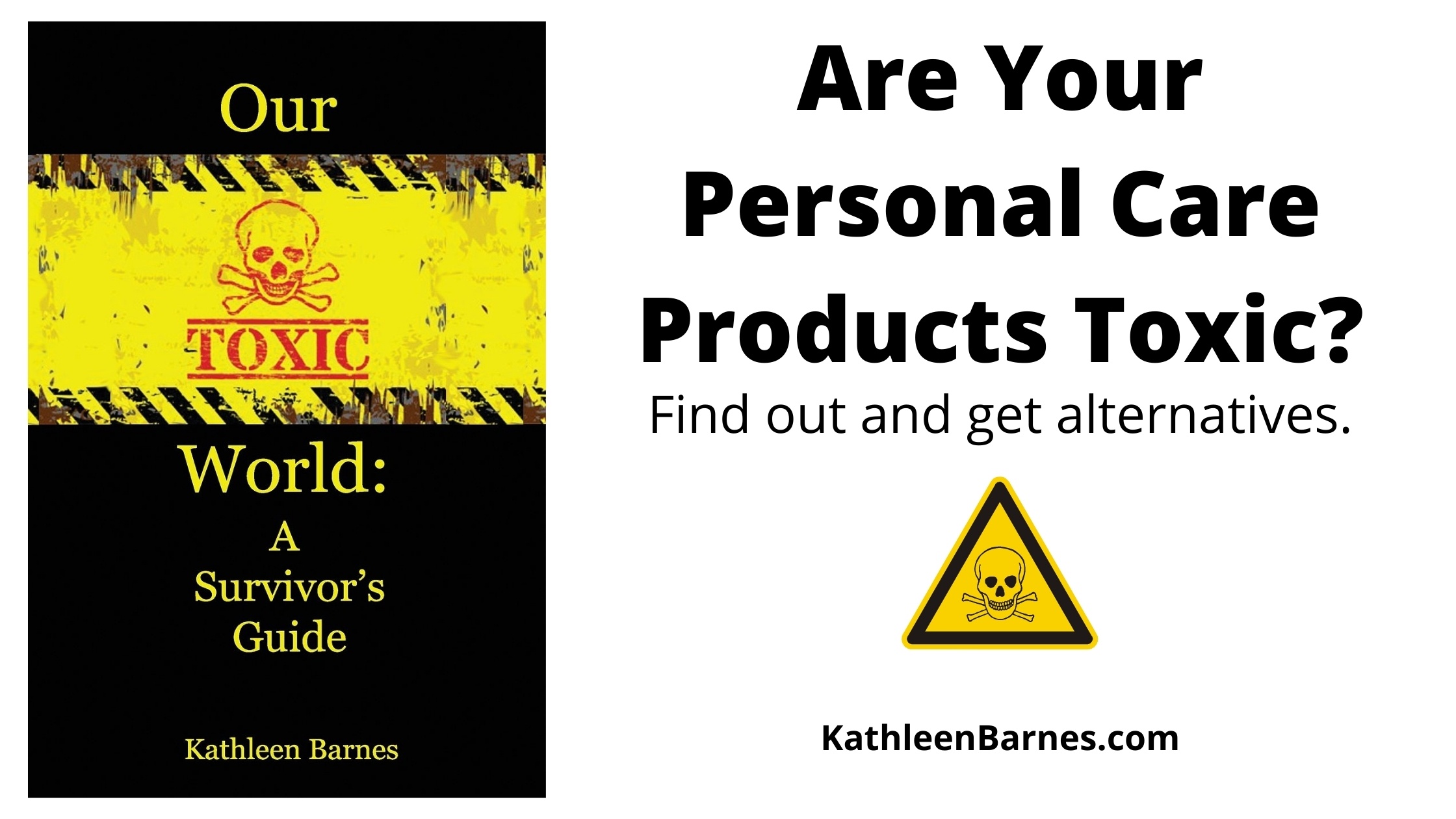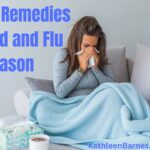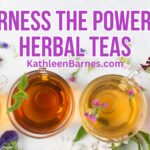 This is an excerpt from Kathleen’s book, Our Toxic World: A Survivor’s Guide
This is an excerpt from Kathleen’s book, Our Toxic World: A Survivor’s Guide
We live in a toxic world. Toxic exposure is inevitable unless we can learn to live without breathing, eating or interacting with any substances around us. If you’ve figured out how to do any of those, please let me know your secret!
Several studies now show us that fetuses are exposed to toxins in the womb. We like to think of our newborns as pure and perfect, but studies from the U.S. Environmental Working Group published ten years ago showed 287 environmental toxins, industrial chemicals, pesticides and cancer-causing substances in the cord blood of newborns.
Today, I’d just like to take a look at our morning routines and the numbers of toxic exposures we all get in the course of simply getting ready to leave the house for the day.
The Basics
- What you put on your body is just as important as what you put in your body.
- Your skin is the largest organ of your body. It is porous, so what you put on the outside of your skin is quickly absorbed into your entire system. Think of your skin more as a sponge than as a barrier.
- Clothing made from natural and organic fibers prevents your skin and lungs from being in contact with toxic substances and vapors.
- Basic personal care products ranging from soap to toothpaste to shampoo are loaded with potentially dangerous chemicals.
- Cosmetics are particularly easily absorbed because they are typically put on our most fragile skin and, in the case of facial makeup, they remain on our bodies for hours at a time and they contain a wide array of toxic substances. This is another COVID silver lining since most of us are wearing very little makeup these days.
Basic personal care items most of us use every day can pose a serious danger. Worst of all, many of these toxic substances are not listed on labels, or they can actually be added to products labeled as “natural.”
Here’s a short list of the most dangerous:
- Pthalates: Those petrochemicals used to make rigid plastics soft and pliable, are also commonly added to cosmetics. Pthalates are linked to elevated rates of endocrine disruption, increasing the risk of breast cancer and other hormonally-related cancers in both men and women.
Perfumes, nail polishes, lotions, hair sprays and many other body care products contain phthalates also labeled DBP and DEHP. DBP is used extensively in body care products and DEHP is present in many household products, which we’ll address in the next chapter.
- Parabens: Another type of hormone disruptor commonly used in shampoos, conditioners, moisturizers. They are xenoestrogens—false estrogens—that interrupt the fertility cycle and can lead to early puberty in children.
- Sodium laureth sulfate: You’ll find it in shampoo, body wash, toothpaste, household cleaning products. Originally made as a pesticide, when combined with other common chemicals, it can form cancer-causing nitrosamines.
- DEA (diethanolamine) MEA (monoethanolomine), TEA (triethanolamine): Commonly found in shampoos, soaps, bubble baths and facial cleansers. These are all hormone disruptors, with a strong link to liver and kidney cancer.
- Propylene glycol: This is antifreeze—found everywhere in shampoos, cosmetics, conditioners, toothpaste, stick deodorants–and ice cream. It’s linked to kidney and liver disease.
- Petrolatum (minerals oil and paraffin): This base of cream, baby rash ointments and many other personal care products coats the skin like plastic, causing toxins to accumulate, disrupting hormonal activity, increasing the risk of cancers and accelerating skin aging.
- Formaldehyde: Found in body lotions, shampoos and conditioners, body washing style gels, sunscreens, makeup and nail polish, formaldehyde is a known human carcinogen that is toxic to the immune system and respiratory tract.
This list is far from a complete list, but it gives you the idea of the level of toxicity we encounter in the most basic products most of us use daily.
What to do
Toothpaste: Most toothpastes contain fluoride, an industrial waste product that disrupts thyroid activity and can cause a rare form of bone cancer. Many toothpastes also include petrochemicals, artificial colors and mineral oil that can cause a wide range of debilitating symptoms, including extreme fatigue, muscle pain, respiratory problems and possibly cancer.
The fix: Use baking soda with a few drops of peppermint oil or a fluoride-free natural toothpaste for safer choices.
Shampoos: Shampoos are commonly made with formaldehyde as a preservative, often labeled quaternium-15, a carcinogen that is also an irritant to skin, eyes and respiratory passages, even in small amounts. Although the government requires some products to carry a warning label, shampoo is not included.
Many shampoos (and body washes and bubble baths) contain chemicals that look like an alphabet soup called BNPD, TEA and DEA that can combine at random to form carcinogenic nitrosamines. Since nitrosamines are easily absorbed through the skin and your pores are open because you’re using hot water, it’s best to avoid products containing them.
Dandruff shampoos usually contain selenium sulfide, which can cause vital organs to degenerate if swallowed. Resorcinol, another easily absorbed ingredient in dandruff shampoos, can cause skin and eye irritation, drowsiness, unconsciousness and convulsions.
The fix: There are dozens of brands of non-toxic shampoos. My favorite is Dr. Bronner’s, a 100% organic product that is gentle on skin and hair. You can also find organic shampoos, although many are only 80 or 90% organic, leaving you to wonder what’s in that other 10 or 20%. Baking soda is the best topical remedy for dandruff.
Soap: Many soaps contain petroleum-derived synthetic fragrances, artificial colors, and mineral oil that may cause skin rashes and other allergic reactions.
The fix: Look for vegetable oil-based soaps or castile without artificial fragrances.
Deodorant: Ordinary deodorants can be a source of harmful chemicals. Virtually all antiperspirants have aluminum chlorhydrate, the active ingredient that prevents wetness that can cause infections in the hair follicles and skin irritations that may be severe enough to require medical attention. It is possible that the aluminum in deodorants may also contribute to the buildup of aluminum in the body, since aluminum from other sources has been linked to brain disorders and Alzheimer’s disease. Aerosol sprays containing aluminum chlorhydrate can also be inhaled, potentially worsening the problem.
The fix: There are lots of natural deodorants. Just walk through the natural body care aisle at your local health food store and you will see a wealth of choices. Plain baking soda works very well for some people. I was sold on those “crystal” deodorants until I discovered they are actually toxic aluminum. My personal solution–don’t laugh– milk of magnesia with a few drops of tea tree oil. It works like a charm, even on a hot day with a brisk walk and a few hours in the garden. You can buy a roll-on bottle cheaply online.
Want more articles about our Toxic World? Click here.







